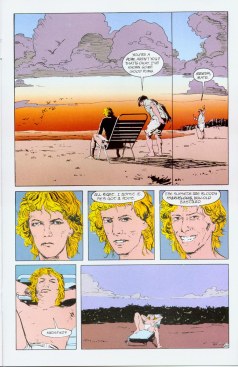Catholic guilt has to be up there with planetary gravity as one of the most crushingly powerful forces in the universe. I say this as a lapsed adult who happened to be reading Mike Carey’s “Lucifer” during Easter Sunday, and still found time to think: “Geez, should I be reading a comic about the merry adventures of this handsome DEVIL on the day celebrating the purported resurrection of my Lord and Savior? There’s been a lot of LIGHTNING outside today…”
I tell ya, they get ya when you’re young, and the damage is done…

The word “Lucifer” is of course, Latin for “light bearer,” the “morning star.” It refers to the planet Venus, and appears once in the Bible, (in the book of Isaiah), as a metaphor for a Babylonian King, doomed to fade as Venus does in the morning sky. As a term, “Lucifer” was used in early Christianity- but not for the Devil! Instead, it was a positive, adjectival name for none other than Jesus (In Latin liturgy, Jesus is still called Lucifer, “The one Morning Star that never sets.”) But tradition has largely settled on “Lucifer” as a description of pre-fall Satan, ( Dante and Milton cemented the use.)
Know then, that after Lucifer from Heav’n
(So call him, brighter once, amidst the Host
Of Angels, then that Starr the Starrs among)
Fell with his flaming Legions through the Deep
Into his place…

DC Comics remakes religion in its own image, though, and the Lucifer so predominant in the Vertigo imprint is mostly a Neil Gaiman construct, sprung from the pages of “Sandman.” This Lucifer is a calculating, sophisticated, cosmopolitan foil to a Deus-in-Absentia (if you want actual religious bite from Vertigo, go read Garth Ennis’ “Preacher.”)
Whereas Milton’s devil is the original anti-hero, struggling against Heaven’s tyrannical hierarchy with all his might, Gaiman’s devil is a laid-back observer of human foibles (and a bit of a pretty-boy “pom,” as a character puts it.) Here’s this classic speech from “The Sandman: Season of Mists,” which sums up Lucifer’s ethos:
“Why do they blame me for all their little failings? They use my name as if I spent my entire days sitting on their shoulders, forcing them to commit acts they would otherwise find repulsive. ‘The devil made me do it.’ I have never made one of them do anything. Never. They live their own tiny lives. I do not live their lives for them.”
Far from obsessing over rotting souls like some OCD-compelled record-collector rummaging a bargain bin, THIS Lucifer has renounced his chthonic dominion, and enjoys relaxing on the beach and conceding that, well, that old bastard God does make a hell of a sunset.

The Devil enjoying a suntan makes for an unexpectedly moving moment of religious sentiment in “Sandman,” but when Carey inherited that kind of character, he inherited a dramatic problem. Gaiman’s Lucifer is TOO laid back, suited to unobtrusively host an anthology series but little more. He’s not evil enough to be interesting, or likable enough for religious subversion. He just feels too RELAXED: a hassle-avoiding tourist, flying first class on his immaculate wings. He recovers those wings in a battle of wits that is a blatant re-do of The Sandman’s recovery of his own attributes, and signals to the way this series lives in the shadow on its predecessor.
Far more interesting (and kick-ass, and half-pretty) is Lucifer’s half-masked follower, Mazikeen. She is one of the Lilim, (according to Jewish legends, the Lilim are the descendants of Adam’s first wife, the rebellious Lilith who wouldn’t submit to Adam’s macho posturing) but she’s relegated to the sidelines in the three volumes I’ve read.

Carey is a good writer, although too comfy in the “Sandman” mold to break free, as he would later in “Crossing Midnight.” The IDEAS are interesting, and more adventurous than Milton’s because they can stray farther from the scriptural tether than Milton could, (although Milton went plenty far.) Many will defensively reject the idea that a little comic book might have as much to say about free will as the great Protestant epic. Those people haven’t kept up with graphic novels.
What fails for me here is the indifferent artwork. Milton had better VISUALS, which is a sad thing to say when comparing words to drawings. Great covers aside, the artistic team in “Lucifer” is not up to the task of creating epic horror, or cosmic awe, or any of the things I want in a book full of demons. And Lucifer himself has rarely been so un-threatening, so lax, so boring, so inactive, so unwilling to break any kind of sweat that could not be remedied by an iced tea. And one does imagine him sipping iced teas.
I’m a minority opinion on this revered classic; I trust Carey and the Vertigo imprint enough to believe the series might have improved a couple of years into its run. “Sandman” certainly did, so I will continue reading, but so far this “Lucifer” is not so hot.
RATING : GOOD ENOUGH


3 thoughts on “Bringing In The Light : Mike Carey – “Lucifer” V. 1-3”